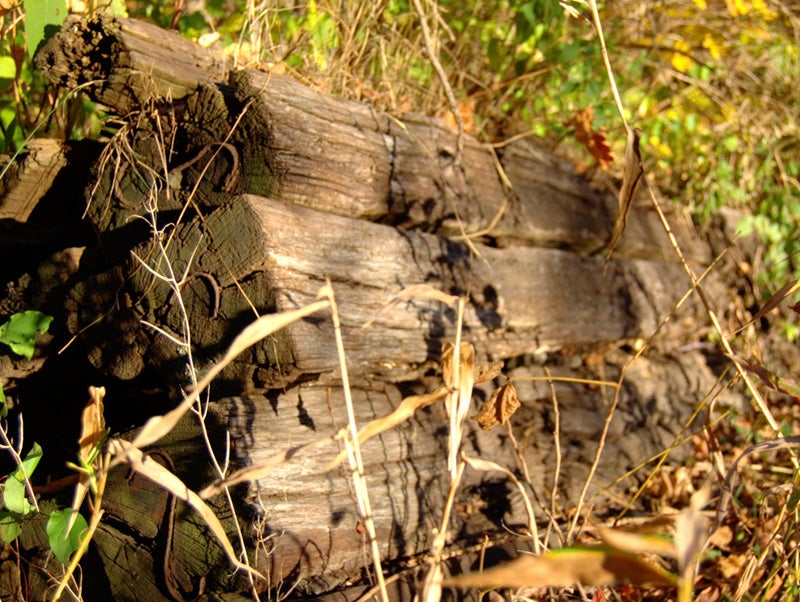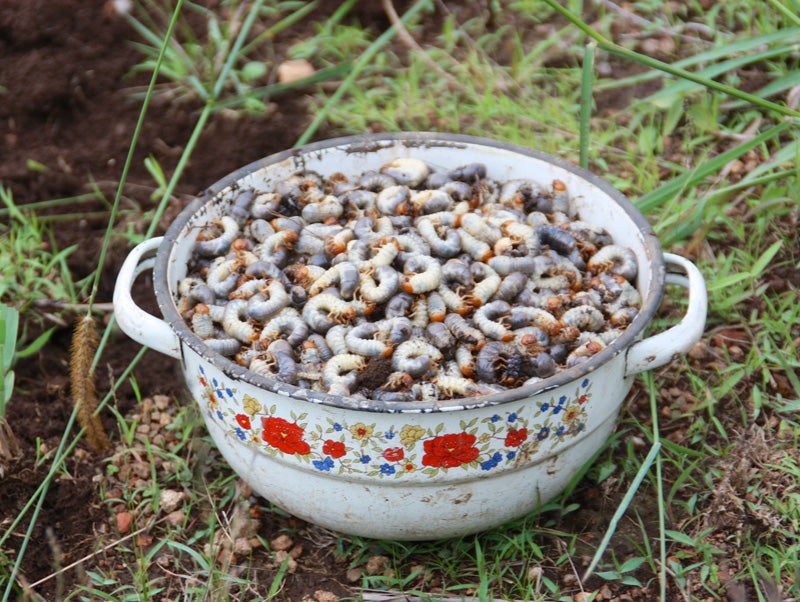Beware of Old Landscape Timbers
Listen 00:52:58It’s a story as old as time, but definitely not from Disney. Mike McGrath, host of You Bet Your Garden, will discuss what to do when you discover that your ‘new’ house comes with old landscape timbers. Plus answers to all your growing questions.
Question of the Week:
“I recently bought a house just over the Pennsylvania border in Maryland. The previous owner had many garden beds, and the one he used for vegetables had old timbers surrounding it that looked questionable. I asked him if they were ‘treated wood’ and he said he didn’t know; that were there when he purchased the house over ten years ago. The timbers are rotted and in bad shape. How do I find out whether they are treated wood; and if they are, do I need to remove all the soil? Is there a place I could take a piece of wood to show someone or have it analyzed?”
— Pattie in Pennsylvania
Railroad Ties are NOT Legal for Home Landscape Use »
-

Photo by Flickr user michael
Highlights from show for May 8, 2015:
White Grubs
Nyla in Alexandria, VA wants to find out if there is an organic method to get rid of white grubs that are demolishing her vegetable gardens. She has also done some research in hopes of resolving her issue and came across nematodes and would love Mike’s feedback. For Nyla to understand the life cycle of these insects, Mike first states that scarab beetles such as these white grubs in the summer time do eat away at plants; females of this variety, search for places of “moist open ground” to lay their eggs such as garden beds. To prevent it from happening as we begin to enter into summer, one thing Nyla can do is add a mulch of shredded leaves or pine straw that might discourage the females from laying eggs there. Mike warns Nyla not to use the nematodes just yet, it is best to save it for when the soil gets warmer for they will not be as productive. Mike adds that the white grubs delve deep in the soil, below the frost line, in the winter; therefore, Mike advises her to be patient until the soil is warmer that way the grubs will eventually reach the top where nematodes can obliterate them. Mid-May, is the perfect time to begin. Additionally, nematodes are bred to purposely kill grubs and do not harm earth worms.”
-

Photo by Flickr user IFPRI-IMAGES
Killing Mushroom Spores
Ed in Detroit, MI has had the misfortune of discovering cup mushrooms growing on his spinach in his green house. He tells Mike that he has been picking them out and composting them, only to realize that the more he picks the more the mushrooms spread. He mentions that his soil is mushroom soil. Mike informs Ed that spent mushroom soil is commonly used, especially in Pennsylvania; however, the mushroom growers in farms steam the soil in order to kill the spores so that when it is sold to consumers mushrooms will not grow. Mike believes that Ed has purchased soil with active spores. Mike advises piling up the compost and allowing it to sit in the sun and somehow steam the soil with either pouring boiling water over it or using some kind of steaming machine or tool to kill any visible spores if spotted this summer. If this procedure is done, most likely this soil can be reused again in the fall.”
Community Gardening
Mary in CA would like to know if it is possible to grow a vegetable garden in her apartment that only receives about half an hour worth of sunlight. She is interested in vegetables such as tomatoes. Mike informs her that plants like tomatoes need six to eight hours of sunlight; therefore, she will not be able to grow them in her home. What Mike would suggest, considering her circumstances, is community gardening. Additionally, he adds that by gardening in the local garden, she can allow her tomatoes to get enough sun but to also take note that they need some shade in the afternoon and she can do that with an umbrella. Mike warns that growing plants in such little light is not healthy at all for it concentrates too much nitrogen which isn’t beneficial.”
Fruitless in New Jersey
Fred in NJ has zucchini plants that he believes have been doing very well with gigantic leaves and flowers. However, “they bear no fruit whatsoever” and has noticed the lower section of the plant is deteriorating. Mike says that at the start of it’s reproducing, it only reproduces male flowers. The plant takes a while for it to produce female flowers especially if it is grown in flat earth, has poor drainage, is chemically fertilized, etc. However, it will be notable when it does happen because female flowers have a bulge underneath them unlike male flowers that have a straight line and make the plant appear straight. Mike believes that Fred is infested with the squash vine borer: these are night flying pests that lays eggs at the base of squash plants; they hatch and make their way deep into the vine making them invisible and demolish the plant. Mike offers him some suggestions. Either he can lightly wrap gauze above where the roots end. The gauze should be halfway above and underground. This procedure serves as a physical barrier against the night flying moth. If Fred wishes to prevent them, once weekly he should spray water in a sharp stream on the plants to ‘blow the eggs off’. Eventually, Mike states that he may notice a hole where he sprays in the ground and he should dig out, with a single edge razor blade, and remove the caterpillar(s).”
Testing the Soil
Jonathan in Philadelphia, PA wants to become a gardener by replanting a year old abandoned garden and would like to know some first-time gardener tips on what crops to plant. He mentions that it is grown into a small square plot that is bricked off and he has recently added new soil and mixed in compost. Mike emphasizes how important it is to test your soil for lead, especially in urban environments like Jonathan’s; he adds that if you inhale the dust it can have a negative affect, but the crops will not absorb it unless there are hugh amounts of it. Mike suggests that it would be better if he layered it with another layer of bricks and fill the extra space with clean top soil and compost and make it a raised bed, avoid working in the existing soil. Wearing gloves, according to Mike are essential for Jonathan; the best gloves for this situation are baseball leather gloves to protect himself from contaminated soil. Once the bed is raised, he can purchase the plants he’d likes.”
New Grass
Rose in NJ has a small grassless property she wants to cover with grass. Her property has varying elevations and in the winter she receives a lot of standing water that turns to ice. She is thinking about installing Zoysia grass and wants Mike’s input on it. Mike ensures her that it is “very tough” and considering her region, installing it will only allow her grass to be green about half of the whole year. Mike prefers that Rose buy rolls of sod. The best way to install a new lawn, says Mike, is to remove what you had before and level the area or even it out. She can hire someone to level the area out, to improve the drainage. “Zoysia grass is really low maintenance, really doesn’t need to be fed, only have to cut it a few times a year”, Mike adds. It is a powerful plant and doesn’t harm anything else. “
WHYY is your source for fact-based, in-depth journalism and information. As a nonprofit organization, we rely on financial support from readers like you. Please give today.

